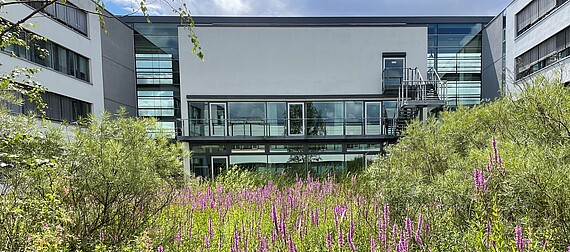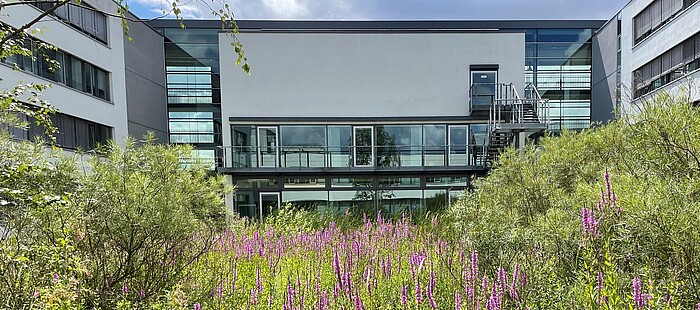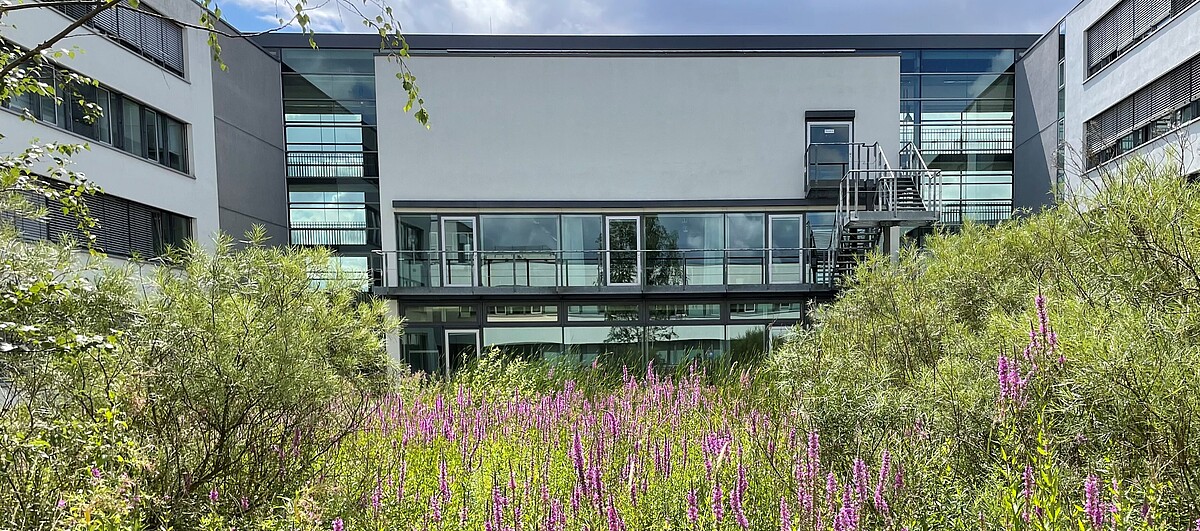

 ©
Stephanie Mittrach
©
Stephanie Mittrach
The campus of Leibniz Universität Hannover has many green spaces that invite to relax and linger. In the following we will present some projects and hidden treasures that make a special contribution to promoting and preserving biodiversity on campus. Don’t hesitate to contact our environmental management if you have any ideas or propositions.
-
„Trees for Future"
![]()
![]()
![]() ©
Stephanie Mittrach
©
Stephanie Mittrach
As part of "Climate Week 2019", students from the Plant Biotechnology and International Horticulture degree programmes together with Prof. Traud Winkelmann (Institute of Horticultural Production Systems) and the Plant Sciences Council designed a concept to plant new trees and create a more sustainable and greener campus for teaching and research. In the run-up to the project, some trees had to be felled due to urgently needed renovation work on the Herrenhausen campus.
To start with, based on previous studies Prof. Winkelmann selected potentially suitable trees for the climate of the future. Following the selection, landscape architecture students under the supervision of Prof. Martin Prominski and Jan-Eric Fröhlich (Institute of Open Space Planning and Design) drew up a plan for the respective planting sites. In the end, trees with a total value of about € 15,000 were donated by the tree nurseries Bruns (Lower Saxony), Lorberg (Brandenburg), Ley (NRW) and Lorenz von Ehren (Hamburg), whose generous help made the realisation of this project possible.
Project implementation started in November 2020. On the 17th of November, planting holes were dug with the help of hanova GEWERBE GmbH. Students, lecturers and LUH staff did the planting on the 18th of November. In this initiative, a total of 18 climate-trees were planted, which are now the so-called Trees for Future on the Herrenhausen campus.
By the spring of 2022, all trees will have been equipped with signs providing information on the tree species and their special features.
There will be an official opening, which due to the Covid pandemic restrictions could not have yet been held.
-
Indicator plant nursery
![]()
![]()
![]() ©
Gina-Marie Burgdorf
©
Gina-Marie Burgdorf
The Institute of Environmental Planning’s indicator plant nursery is located between the university buildings Str. 2 and 2A and comprises more than 500 wild plant species on a total of 24 beds. Signs have been put up providing information on the combination of indicator values of the individual plant species, including values to indicate dryness and wetness, acidity and lime, leanness and nitrogen. The indicator values define which environmental conditions the individual plant species can tolerate and require in order to thrive and compete with other species. The garden provides valuable materials for lectures and identification exercises, and it can also be used for self-study initiatives. The indicator plant garden is open to all interested parties on weekdays and is accessed via the main entrance at Herrenhäuser Straße 2.
For more information please refer to the website of the Institute of Environmental Planning.
-
Tree garden
![]()
![]()
![]() ©
Stephanie Mittrach
©
Stephanie Mittrach
The Institute of Environmental Planning’s garden with woody plants was created in 2009. The garden contains a collection of almost all the native woody plants as well as ornamental trees that are used in landscape architecture. The garden is located on the university campus at Herrenhäuserstraße 2, at the corner of Burgweg and Haltenhoffstraße. It is designed to enable students of landscape architecture and environmental planning to gain knowledge of the various woody species by observing their response to the change of season. In autumn 2022, the planting of the trees will be continued to complete the implementation of the woodland garden project.
Further information can be found on the website of the Institute of Environmental Planning.
-
Walled gardens - reviving a green treasure
![]()
![]()
![]() ©
Stephanie Mittrach
©
Stephanie Mittrach
There is a green gem on the Herrenhausen university campus, hidden behind wild roses, ornamental apples and walls. The walled gardens are part of the educational and experimental gardens that have been built in the second half of the 1950s under the initiative of the then Institute of Horticulture and Local Culture that was founded in 1947 – which today is the LUH's Department of Landscape Architecture and Environmental Planning. The listed historic garden consists of seven interconnected and walled spaces with different structural and plant features, measuring between 20 and 400 m². They are used, especially by students, as objects for the study of spatial proportions and the use of materials and plants.
Research and teaching at the Institute of Landscape Architecture focuses on, among other things, plant use (Prof. Anke Seegert) and the technical-constructive fundamentals of open space planning (emeritus Prof. Gilbert Lösken, retired since 2021). For some time now, the Institute has been working on rejuvenating and restoring the garden facilities. Together with the scientific and horticultural staff and a group of student assistants, necessary conservation measures have already been successfully implemented. Projects such as the renovation of a water basin and pergola are currently being completed. In addition - just in time for the 75th anniversary of the Landscape study programme - several perennial and woody plants beds are being built.
The biggest challenge in the future will be caring for and maintaining the valuable green spaces to keep this living laboratory garden organised. With increasing cuts in garden maintenance staff, we are facing an uncertain future. Repair measures that have already been carried out and those in the pipeline can have a lasting and sustainable impact only if ongoing garden maintenance is guaranteed.
Philipp Ludwig from the Institute of Landscape Architecture will be happy to answer any further questions.
-
Insect Hotels
![]()
![]()
![]() ©
Stephanie Mittrach
©
Stephanie Mittrach
One of the goals of the Green Office at Leibniz Universität Hannover (LUH) is to improve biodiversity on campus through various projects. Therefore, in November 2022, two insect hotels were installed for the first time in the Welfengarten. In 2023, a funding for four insect hotels has been approved. The wild bee hotels were installed in 2024 at the Mechanical Engineering Campus in Garbsen, the Herrenhausen Campus, the Sport-Campus and in front of the Institute for Didactics of Natural Sciences.
When planning the location for the insect hotels, a garden and landscape planner was consulted to determine which sites would be most suitable. The project is supported at the respective locations with educational work through personalized information boards to inform passers-by about the nesting species and to sensitize them to the topic.
This project was resp. is funded by the Lower Saxony BINGO Environmental Foundation.
Applicants: Stephanie Mittrach, Joshua Brüggemann, Matti Benne
Duration: June-November 2022 and July-March 2024
-
The Insect Alliance
The Insect Alliance, initiated by NABU Hannover, BUND Region Hannover, Deutsche Umwelthilfe and Umweltzentrum Hannover, comprises over 20 partners and has set itself the goal of jointly promoting insect conservation in the city of Hannover.
By joining the insect alliance, LUH will successively examine its open spaces in the urban area to improve the habitats for insects and redesign them accordingly. This includes the creation of biotope networks, the improvement of nesting and hibernation facilities and the use of insect-friendly light sources. Insect-friendly, native and regional plant species are also preferred when redesigning areas.
Measures already successfully implemented by LUH include the creation of flowering meadows on campus, the revitalization of the wall gardens and the installation of insect nesting aids. These activities are part of LUH's strategy to contribute to the preservation and increase of biodiversity in Hanover.
-
Company gardens
![]()
![]()
![]() ©
Petra Schmiedner
©
Petra Schmiedner
As part of the project "Außenstelle Natur - Firmengelände naturnah gestalten" “Branch office Nature Garden – Design of company premises close to nature”, which will take place from October 2019 to September 2024 in cooperation with the Umweltzentrum Hannover e. V., Leibniz Universität Hannover will be supported in the climate-adapted conversion and redesign of the company grounds. The aim is to sensitise university staff and students to nature-oriented design and biodiversity in times of climate change. Within the framework of the project, a near-natural and insect-friendly show garden is to be created on the grounds of Leibniz Universität Hannover with the help of the Umweltzentrum Hannover e. V.. The show garden will display drought resistant native plants. For educational purposes, info boards will be set up for staff, students and the interested public to provide information about the project and the connection between climate change and biodiversity and finding suitable plants. The construction of the show garden provides two benefits: a tool for acquiring insight in suitable redesign measures for the university grounds to meet the challenges of climate change and achieve ecological sustainability "on a small scale", and establishing the necessary networks to implement the redesign of the university grounds to tackle climate change. The info boards will ensure that the show garden also makes a contribution to climate change education.
The planned show garden is to be built at the end of the Schneiderweg 32 site, comprising about 72 fenced in square meters. The Nordstadt area is densely populated and has a number of kindergartens, which means that there are a lot of passers-by. In addition to this, the immediate proximity to the Pferdestall event center makes this site ideal for a show garden. The goal is to involve students in the project, with the support of the Institute of Landscape Architecture, who will provide hands-on support for the planned planting activities.
-
Nesting boxes for birds and bats
![]()
![]()
© Prof. Ing. Kai Brunotte
A pair of falcons has been observed on the Garbsen campus several times in the past. Therefore, the Green Office has decided to obtain a falcon nesting box and thus to make a further contribution to the promotion of biodiversity on the campus. Dr. Ing. Kai Brunotte from the Institute for Forming Technology and Forming Machines installed the falcon nest box together with the janitors.
Furthermore, Dr. Brunotte also manufactured and installed two perches. With these perches, the birds of prey have targeted approach opportunities on campus to facilitate perching.
![]()
![]()
![]() ©
Jasmin Vu
©
Jasmin Vu
In October 2022, twenty new nesting boxes of the company Schwegler were placed in the Welfen Garden of the LUH. Among them are specialized nesting boxes for the blue- and great tits, sparrows, redstarts and the nuthatch. With varying holesizes, integrated and angled retreats for bats and incorporated covers against cats and martens, a required protection is given to the birds for raising their hatches. They can also serve as retreats for the winter. The Green Office was assisted in choosing the nesting boxes by the Naturschutzbund Deutschland (NABU). To control and monitor the breeding success in the following years as well as maintaining the boxes, a documentation and numeration of the bird housed were done.
-
Wild watering hole
![]()
![]()
![]() ©
Linhart 2023
©
Linhart 2023
Wild watering hole
The increasingly warmer summers are also causing natural water sources to dry up more quickly. For this reason, the Hannover Animal Shelter has launched the project Wildtiertränken gegen Durststrecken. The centrepiece is a tubular watering trough that can hold up to 10 litres of water and serves as a reliable source of water in summer months. In the summer of 2023, a wildlife watering hole was temporarily integrated at a young tree on the corner of Appelstraße/Schneiderberg on the LUH grounds. This way, both small animals and larger nocturnal visitors can be supplied with liquid in dry months. Two volunteers take care of the maintenance of the facility.
Further information on the project can be found on the website of the Tierschutzverein Hannover.
You can find a construction manual for a wildlife watering trough for private use from the Tierschutzverein Hannover here.
-
Wildflower and insect meadows on campus
![]()
![]()
![]() ©
Stephanie Mittrach
©
Stephanie Mittrach
Wildflower and insect meadows can be found at various locations on the Leibniz University campus. In the Welfengarten, there are a total of three green spaces in the north and south, each of which is only mown twice a year. The central meadow of the Mechanical Engineering Campus in Garbsen is also laid out as a near-natural area. It is also extensively maintained so that wildflowers and herbs can grow. In addition, there is a flowering meadow between the C and B squares on the SportCAMPUS and a mixed herbaceous planting in front of Hall 1. Green roofs have also been laid out at the Hanover Centre for Production Technology (PZH) and at other locations. Further flowering meadows for insects are being planted specifically - and in consultation with Department 3 - with regionally certified seeds. Employees can also get involved here.
































